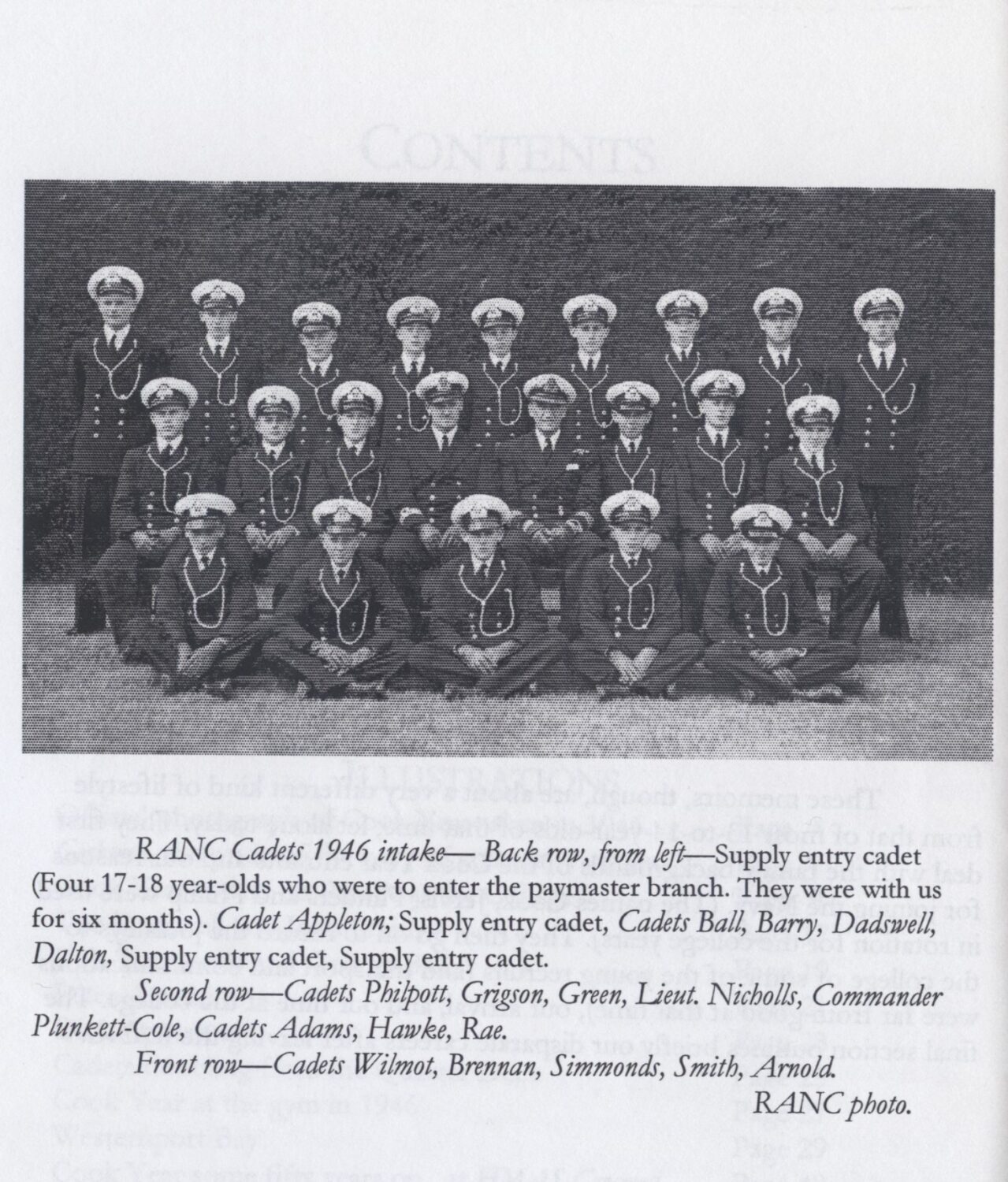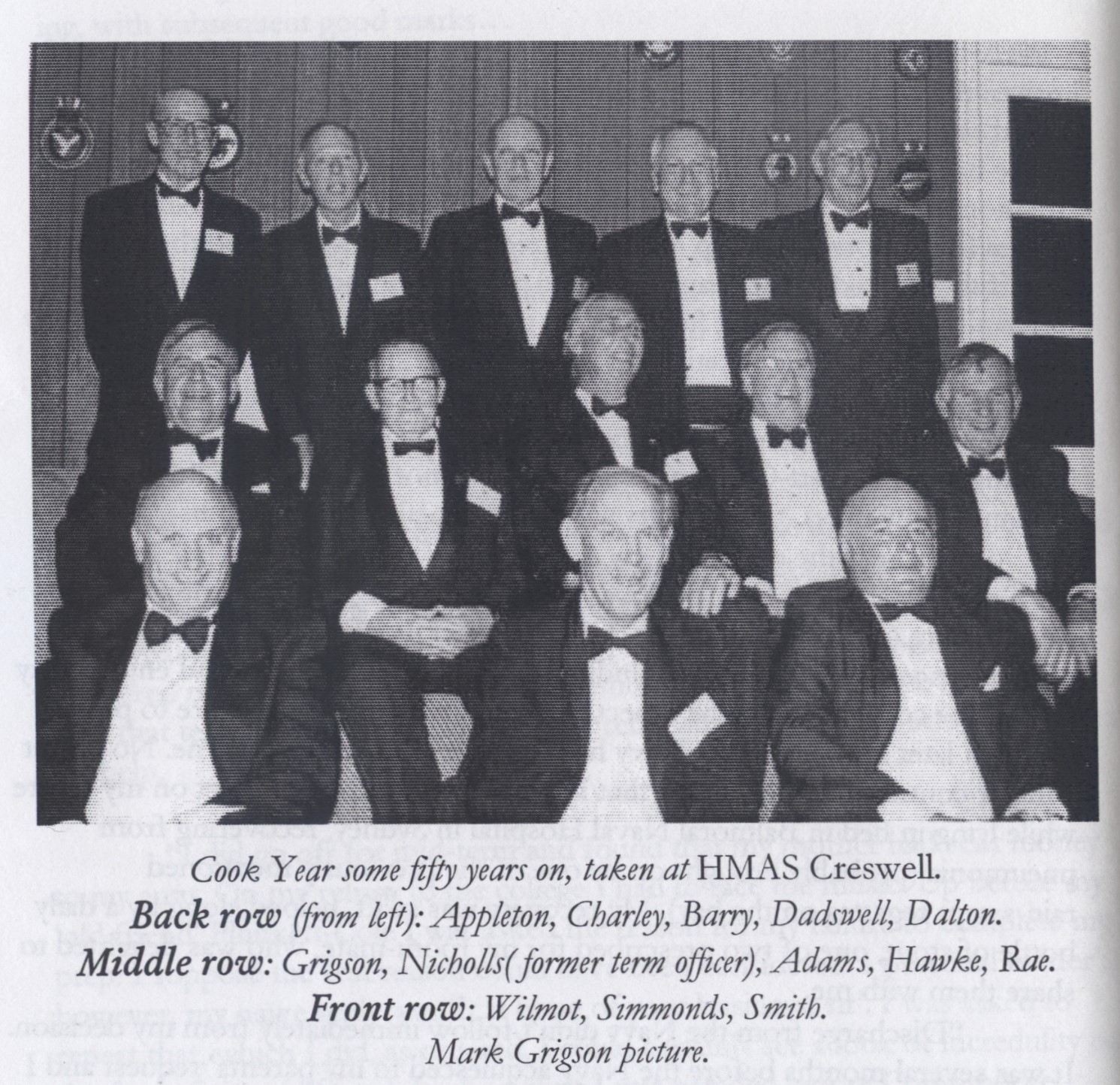- Author
- Editorial Staff
- Subjects
- History - general
- Tags
-
- RAN Ships
- HMAS Cerberus (Shore Establishment)
- Publication
- September 2023 edition of the Naval Historical Review (all rights reserved)
The June 2023 edition of this magazine contained an article Tristan da Cunha and a Tribute to John Smith, providing a shortened version of the remarkable life story of Commander John Smith RAN Rtd who passed over the bar on 3 February 2023. John was one of small group of youngsters who were the first post-war entries of Cadet-Midshipmen into Flinders Naval College in 1946, known as ‘Cook Year’.
The published record of Cook Year is comprised in a slim volume, Brave British Boys, edited by one of their number, Richard Appleton, and published by the Naval Historical Society in 2003. From this and with assistance from the few remaining contemporaries we have been able to produce a picture of life in the RANC at the beginning of the post-war period, which seems far removed from an era of enlightenment.
Brave British Boys was produced from reminiscences provided by ten of this cohort; another four were unwilling to contribute, and by the time of publication two had died. Now (August 2023) with the passage of time, only three of Cook Year remain with us.
With a limited number of places available the process of ‘getting in’ can be daunting, but the process of ‘getting out’ was perhaps less demanding. We are informed by no lesser authority than CDRE Harold Farncomb CB DSO MVO, who was the Commodore Superintendent of Training and Commanding Officer of HMAS Cerberus, that there were 800 applicants from all over Australia for the limited number of 16 places on offer to the 1946 entry.
Getting In
Those who applied and judged suitable were invited to sit a written entrance examination held in November each year for the Thirteen-Year-Old entry, usually at a central place in each state capital. The exam foreshadowed the RANC syllabus, requiring a knowledge of Mathematics, Physics, Chemistry, English, History, Geography and another language.

*Supply entry cadets: Four 17-18 year olds of the Paymaster Branch. They were with us for six months.
The results from these examinations enabled the RAN to select the very best of academically qualified students. When successful candidates had overcome this preliminary stage they were invited to Melbourne for a medical examination, followed by an interview in front of a panel of senior officers. This comprised CDRE Farncomb, the Commander of the College, CMDR John Plunkett-Cole, and the Director of Studies Mr H.D. Simpson. The panel considered the personality of the candidates, their bearing, manner of speech and other aspects of character. After this the candidates were ranked in order and the best selected offered places at the RANC. This was not a simple process as ideally, cadets were selected on a proportional basis depending upon the population of each state, with at least two places being offered to the sons of those who had served in the RAN.
In practice this particular entry was severely skewed in favour of New South Wales with eight coming from NSW, three from Victoria, two from Queensland, two from Tasmania and one from Western Australia, with none from South Australia. These numbers could be manipulated by including the Paymaster entry which would add a further three to Victoria and one to Western Australia. Another surprising feature was that of the seven NSW entrants four came from the same school, North Sydney Boys’ High. Nearly all the entry came from a similar middle class demographic, attending private or selective schools.
Some records show Cook Year having an initial entry of 20 students. This is because four older boys entered under the Paymaster scheme; J.H. Cram, W.A. Kemp, C.J.A. Parker and W.B. Wilson joined for six months common training. Another exception who joined in 1947 was Jim Charley who had been sent down from the year above; unfortunately he did not remain for long, being discharged in 1949.
The Examinations
The following is one of the written examination papers (History) sat by the candidates. The majority of the 13-year-old candidates seemed to think that this type of written exam was relatively easy.
HISTORY
Time allowed One hour
Attempt FOUR questions only, two from any one section and ONE from each of the other sections.
SECTION A
- Alfred the Great was a Saxon warrior who loved learning. Write what you can about him.
- Write one sentence about each of the following:
- Watling Street;
- The Bayeux tapestry;
- Harold Hardrada;
- Doomsday Book;
- Magna Carta.
- Tell a story about either William Wallace or Robert Bruce.
SECTION B
- Why is the voyage of the Portuguese nobleman, Vasco de Gama, considered important in British history? What did he do?
- What was a theatre like in the days of Shakespeare?
- Why did Charles I quarrel with his Parliament? What was the result of the quarrel?
SECTION C
- How were England, Scotland and Ireland united? How is this union represented in the ‘Union Jack’?
- Why is George Washington such a famous man? Tell something about his life.
- What famous inventions improved the manufacture of cotton goods in the eighteenth century?
SECTION D
- What is meant by the Cabinet? How did the Cabinet system of government come into existence?
- Explain how Canada became part of the British Empire.
- Tell something of the work of George Stephenson and the introduction of railway trains.
SECTION E
- On the map of Australia provided:
- Shade with your pencil the part of the coast discovered by the Dutch;
- Mark the track of Tasman’s ships;
- Mark the track of Flinders Investigator in South Australian waters;
- Mark the name Central Mt. Stuart, Stuart’s Stoney Desert, Darling River, King George’s Sound, Port Essington.
- Tell how Hargraves made his discovery of gold in 1851.
- What are the two houses of Federal Parliament called? How many members are there in each house, and how are they chosen?
Interview and oral examination
One of the candidates, Peter Rae, made notes immediately after his interview which are recorded in manuscript on Launceston School notepaper, although this list may be incomplete:
- Why do you want to join the Navy?
- What would you do if you came to Melbourne by boat and while on shore your wallet with everything in it was stolen and you could not get back on the boat to finish your journey to Sydney?
- Look at a tower a few blocks away – then, how many ships do you see?
- Where are these towns: Rockhampton, Simon’s Town, Durban, and about six others, some of which I did not know?
- What are the two tropics and what are they named after?
- Name some famous old sea battles and the dates of these?
- Name some Australian Navy ships.
- Name some British ships in the Pacific Fleet.
- What naval ship was in Melbourne recently?
- Have you been aboard a warship?
- Where is Flinders Naval College?
- In the Seven Years War name some battles.
- Who captured Quebec and what was the date?
- What sea battles have Australian ships served in?
- What are these ranks – pointing to stripes worn by Commodore and Commander.
- Name three ports of call on the Suez route.
- Showing image of a clock face then testing knowledge of Roman numerals.
- What time would it be with 20 minutes to 12 turned back to front?
- Do you write left handed?
- Do you bowl or bat left handed?
- Do you kick a football left footed?
- Asking for my school cap they then asked – the motto, the meaning of it and the three main objects on it.
- Name the three colours on my school tie.
- Where did I sit the educational exam?
- How many students were there?
Joining the College
After this ordeal the process of joining the Naval College was relatively straightforward, although this could take several days with train travel between the mainland states and a sea passage from Tasmania. At this time parents had to guarantee payment of a penalty should a candidate not complete their training at the College.
As mentioned in our earlier article (NHR June 2023) Cook Year was unique in being the first peacetime intake after four years of war. It was a time of change but with naval training methods steeped in tradition it was some time before a more enlightened approach took hold. At this time the college was, in many respects, an outmoded boarding school run by senior fourth year cadets who believed in discipline, especially of the recently joined juniors.
Many of the new entrants were extremely unhappy with the training regime and could not comprehend the relentless punishment inflicted upon them by their immediate superiors; those who were in overall charge seemed to lack understanding or compassion. It is little wonder therefore that many junior cadets made overtures to their parents to release them from this institution.
The Numbers Tell a Tale
CDRE ‘Toz’ Dadswell AM RAN Rtd and CAPT Laurie Watson RAN Rtd compiled a statistical analysis of results from the Naval College between 1913 and 1986. Those from the 1946 Cook Year show an entry of 20 students (including four from the Paymaster entry) but excluding the one late entry from the year above. Only nine graduated, with eleven withdrawals and one dying on active service; none reached Flag Rank but three, including one Paymaster, made Commodore. The Chief Cadet Captain and King’s Medallist of Cook Year was T.A. Dadswell.
Little is known of the older Paymaster entry but their results are even more disturbing. Of these four young men three had been discharged within their first year of service. Only one, William Kemp, made the navy a career which included being Captain of HMAS Cerberus: he retired as a Commodore in 1983 after 37 years of service. Eighteen year old cadet Midshipman William Blair Wilson from Western Australia took matters into his own hands and absconded from the College on 2 June4 1946; he tried to make his way home but was recovered a few days later. He returned but was discharged ashore on 15 August 1946.
The dropout rate, known as withdrawal, exceedingly wasteful and cannot be put down to poor candidate selection or their aptitude but is more likely to reflect badly on an uncaring training regime unsuited to the rapidly changing post-war environment.
The circumstances are perhaps best summed up by Harry Adams, one of the youngsters who would have a successful naval career including command of Cerberus. Commodore Adams was awarded an AM and retired from the RAN after 41 years of dedicated service. In Brave British Boys he says:
‘Certainly as far as I am concerned I learnt precisely nothing about management or leadership in my four years at the naval college. They could have been four stimulating years, academically, socially and experience-wise. Instead, the regime was a relic of the worst aspects of the Navy, and with hindsight I am surprised that anyone ever graduated.’
In summary it may have been difficult to gain entry into Cook Year of the Royal Australian Naval College but once there it was survival of the fittest with little thought given to helping those having difficulty adjusting to the new routines. In practice, getting out of the College appeared much easier with more leaving than joining. If greater empathy had been shown and better care taken, could many of the wasteful withdrawals have been avoided?
References
Appleton, Richard (Edited), Brave British Boys, Naval Historical Society of Australia, Sydney, 2003.
Commonwealth of Australia, The Navy List October 1946, Government Printer, Melbourne, 1946.
Cunningham, I. J., LCDR, Work Hard Play Hard: The Royal Australian Naval College 1913-1988, Australian Government Publishing Service, Canberra, 1988.





